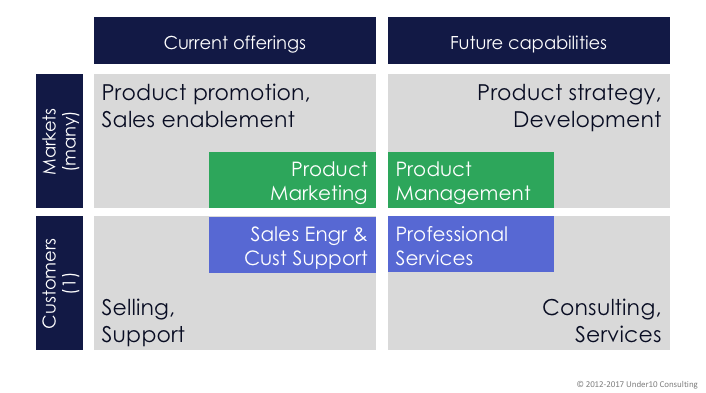
What is (and isn’t) product management?
by Steve Johnson
In a well-run organization, each role has a single orientation; they either support [individual] customers or they support the market. —Peter Drucker, American management consultant, educator, and author.
It seems most organizations are unclear on roles and responsibilities. Here's a handy way of thinking about roles philosophically.

Some company roles, such as sales people and customer support teams, focus on customers one at a time. Marketing, product management, and development engage with a market, in other words, many or all customers at one time.
Visiting a customer with a sales or support objective isn’t product management; that’s selling and support. Interviewing and observing a number of customers to understand their workflows and buying journeys is product management, as we use the information to understand the needs of a market, not just the needs of a single customer.
We often break product leadership into two groups: product management (or product strategy, if you prefer) and product marketing. In general, product management focuses on future products and capabilities while product marketing focuses on current offerings. In both cases, their activities are targeted to a market full of customers: defining and delivering the right products by empowering teams with understanding of markets, products, and goals.
Current offerings are the focus of product operations (if you have this role) as well as sales teams (including sales engineering) and customer support.
Perhaps the most common problem I see is the understaffing in other departments leads to overwhelming demands on your product management team. [tweet this] Because there are rarely enough sales engineers, product managers support individual sales people with technical information. Because professional services teams want its members to be billable at all times, product managers spend time creating statements of work. Even though these are important activities, they’re not product management.
How to use this
For product managers and others in your organization, write down common activities that require significant time. Consider each one briefly and decide if it helps one customer or many, and if it's about current product or future products. If you have a significant number of activities in the bottom row, discuss the staffing and expertise in sales engineering and professional services. If most activities are on the left side, then discuss who is thinking about future deliverables.
If leadership is doing the upper-right, then they're doing product strategy. The one who owns an activity is the one who writes it down and keeps it current. Are these activities owned?
What is (and is not) product management is a common discussion in almost any organization. Instead of looking at a bunch of activities and saying, this is and that isn't, look at this activity matrix and declare, product management is determining product strategy.
The goal of product management is to systematically turn ideas into businesses.

